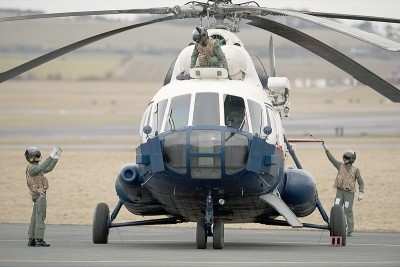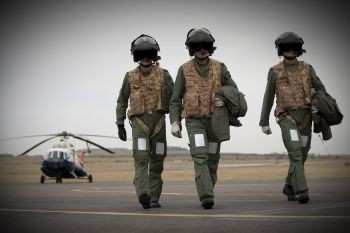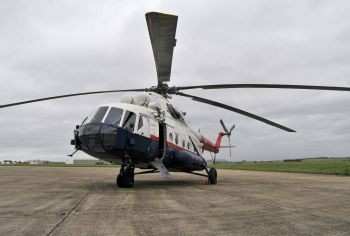Students Overcame Technical, Cultural, And Language
Challenges
27 Afghan Aircrew are being trained in Wiltshire as part of a
two year program run by the UK Joint Helicopter Command (JHC),
supported throughout by QinetiQ. Training of the Afghan Pilots and
flight engineers began in February 2008 at Boscombe Down under
PROJECT CURIUM.

The aircrew have been trained on fixed wing and rotary wing
aircraft and are nearing the completion of their training in the UK
in March 2010. They will fly the Mi-17 when they return to
Afghanistan where their training will continue.
"I'm delighted with how all the Afghan students coped with the
cultural, language and technical elements of their training,"
stated Wg Cdr Al Smith, Officer Commanding the Special Duties
Squadron (SDS).
"The students, who are officers in the Afghan National Security
Force, took part in English classes before beginning their flight
training with 10 hours on a Firefly airplane before each spending
over 60 hours in the Gazelle helicopter. They then transferred to
the Mi-17 helicopter, flying over 40-hours each including basics in
tactical flying, formation keeping, confined area landings and some
defensive maneuvers. Their training will continue once they arrive
in Afghanistan, preparing them for operating in the hot and high
conditions there, enabling them to both build on and share what
they have learned."

QinetiQ initially provided Release to Service recommendations
for the two Curium Mi-17 aircraft, enabling them to be placed on
the UK military register, with follow on recommendations to
increase capability. It has subsequently provided a comprehensive
range of managed services including airworthiness capability and
the full range of engineering support needed to maintain the
aircraft. The QinetiQ team of over 25 has also been fully supported
in engineering activities by its sub-contractor Helisota, a
Lithuanian maintenance and repair company with extensive Mi-17
aircraft experience. Helisota has provided several engineers with
specific Mi-17 experience to assist in the maintenance of the
aircraft as well as providing Post Design Services capability.
"This was a unique project; we faced a huge challenges and we
were working to very strict timescales," explained Jeff Gardner,
QinetiQ's Technical Manager of Project Curium.
"You have to be pragmatic when faced with these challenges, but
we were able to rise to the challenge and approached countries with
appropriate experience and experts who had used the aircraft for
additional support. The aircraft arrived in the UK with some issues
which had to be solved before they could be used for training. The
cockpit instruments had to be anglicised from the aircraft's native
Cyrillic, although some instruments still bear elements of the
Russian alphabet. QinetiQ was also tasked with producing a new
maintenance timetable that reflected existing UK operating
standards and the experience we have gained puts us in good stead
should we be asked to develop civil or military support programs
for other 'unusual' aircraft types in the future."
One of the pilot instructors is Royal Navy Lieutenant Bridget
Compain who has carried out several tours of Afghanistan. She was
keen to volunteer when she heard about the chance to fly the
aircraft and train Afghan crews in their use.
Lieutenant Bridget Compain said "When I heard about the project
I was excited about flying the aircraft and the challenge of
training the Afghans and it has proved thoroughly enjoyable. It is
a unique experience to have the Mi-17 in the UK and especially on a
military register. I love flying the aircraft and the students have
been fantastic - studious, respectful and hard working. It has been
very rewarding. The language barrier is the biggest challenge. But
as an instructor you just need to be sure you word any instructions
in a clear way."
Two of Lt Compain's Afghan students, Karim and Sayeed
(preferring not to give their full names for security reasons) said
they were looking forward to using their skills for real in
Afghanistan. 2nd Lieutenant Karim, who had never flown previously
and was selected for the course from the Afghan Security Forces,
said his first time flying a helicopter in the UK was "big
fun".

He praised the instruction he had received from the British
staff but said he was keen to return to his home country and put
his skills into action. "I now want to help my country and serve my
people," Karim said.
Sayeed, another Afghan trainee helicopter pilot said "I want to
work for our people. I want stability in my country, and I want
peace in my country, because we are anti-terrorist. We are against
those people who are against our country. So if those people are
against us, so I am against them, this is for sure. That's why I am
training."
This is a small-scale project with a high return. Time and
effort invested in training the Afghan crews enables an eventual
withdrawal of UK forces and the program has already yielded
tangible results. A number of crews have completed their training
and returned to Afghanistan where initial reports suggest they are
a well-respected, competent and motivated cadre of professionals.
The crews trained here in UK are the seed corn of an indigenous
Afghan National Security Force helicopter capability.
 Classic Aero-TV: The Switchblade Flying Car FLIES!
Classic Aero-TV: The Switchblade Flying Car FLIES! ANN FAQ: Q&A 101
ANN FAQ: Q&A 101 ANN's Daily Aero-Term (04.12.24): Discrete Code
ANN's Daily Aero-Term (04.12.24): Discrete Code ANN's Daily Aero-Term (04.13.24): Beyond Visual Line Of Sight (BVLOS)
ANN's Daily Aero-Term (04.13.24): Beyond Visual Line Of Sight (BVLOS) ANN's Daily Aero-Linx (04.13.24)
ANN's Daily Aero-Linx (04.13.24)





